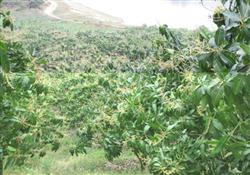How to prevent early flowering of mango

Mango is an evergreen fruit tree, consumption of water and nutrients, such as long-term dry weather, coupled with improper management of water and fertilizer, once the accumulated temperature is satisfied, flower bud differentiation is fast, early flowers will appear, easy to be damaged by cold weather; flowers can not be pollinated, fruit setting rate is low, resulting in yield reduction or loss of harvest. So how do you prevent mango early flowering? First, pruning branches: old, weak, residual, sick, dense, shade and cross branches will be cut off after fruit harvest, and at the same time cut off the remaining fruit axis, and then clear the garden. This can promote the germination of new branches and ventilation, reduce nutrient consumption and pest damage, but also delay flower bud germination, control early flowering. Second, the application of fertilizer: mango flowering and fruiting to consume a lot of nutrients, in the fruit after heavy fertilizer, fertilizer should account for about 80% of the annual amount, to meet the needs of restoration growth and expansion of the crown. Nitrogen, phosphorus and potassium are mainly used, and circular ditches are dug under the crown projection to apply them. Compost, manure and farm manure are applied to each plant with 40~60 kg or compound fertilizer with 7~10 kg, and the soil is covered after application. 3. Prevention of drought damage: Mangoes avoid drought and fear waterlogging. Severe drought has occurred continuously in summer and autumn this year. Flower buds differentiate quickly and bloom ahead of schedule. In order to prevent drought damage, the orchard topsoil will be plowed and loosed to reduce water loss. Autumn and winter drought time is longer, every month should be enough water (conditional irrigation)1~2 times. At the same time, irrigation ditches were opened around the fruit field to prevent heavy rain and waterlogging. Raise the soil at the base of the fruit tree to make the waterlogged water drain quickly. Before winter, spray pesticides 1 to 2 times to prevent pests and diseases. 4. high-grafting and seed replacement: high-grafting and seed replacement should be adopted for those varieties that grow and develop quickly and are prone to early flowering under long-term high temperature weather. The whole plant is changed into fine late maturing variety, so that flowering and pollination are delayed and the harm of low temperature and rainy weather in early spring is avoided. 5. Regulate flowering period: remove the early inflorescences and make them bloom again. To a certain extent, it can delay flowering and avoid the harm of cold. That is, when the inflorescence is 8~10 cm, the flower is picked. However, before the middle of February, flower picking can only be carried out once or twice. If the number of flower picking is too many, the flower vigor is weak, and the pollination ability will be lost. 6. Drug flower control: When flower buds appear, spray with 350 times solution of paclobutrazol or 1000 times solution of ethephon, spray once every 12~15 days, spray 2~3 times continuously, can receive flower control effect.
- Prev

Cultivation techniques of Mango in four Seasons
Mango flowering and fruit setting period is a very important period in mango production and management. the management measures of mango flowering and fruit setting period are as follows: 1. Arrangement of flowering branches and shoots. Remove overdense branches, shade weak branches and disease and insect branches about 2 months before flower bud differentiation, leaving only 1 or 2 shoots per branch, which can increase the crown.
- Next

Cultivation and management techniques of mango trees
First, orchard construction and planting 1. According to the topographic trend of the orchard, the orchard should set up a good bed to prevent rain, water and soil erosion. Dredging drainage channels, the whole garden border ditch and Huanyuan ditch must be unblocked. To achieve self-drainage of rain, no waterlogging after rain, to achieve the purpose of artificial water control; at the same time, people in the garden.
Related
- Moge, come on! The staff of the peasant association in the producing area of cantaloupe were frightened when the crowd gathered.
- Causes and Solutions of low Fruit setting rate of Apple
- Symptoms and control measures of passion fruit virus disease
- Fruit growing lesson: how do apple orchards keep high yields?
- Can you build orchards in the mountains? What are the pros and cons?
- How to manage the coloring period of Crisson grape?
- This paper introduces the processing technology of two kinds of fig products.
- How much is a month for retired teachers in rural areas by 2020?
- How can strawberry planting increase sugar content? We should pay attention to management in many aspects.
- What are the cultivation techniques on how to improve the yield of golden fruit?

